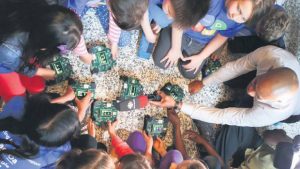
(ROBERTA BAKER/U OF T ENGINEERING)
October 20, 2016 | STEM Education
An innovative outreach initiative of University of Toronto Engineering, in partnership with the Toronto District School Board (TDSB), introduces coding basics to local teachers who can take those skills back to the classroom and use them to enrich lessons ranging from robotics to language arts.
“We are empowering students to think of themselves as inventors, creators and makers, and to learn to engage with technology, rather than be passive consumers,” says Dawn Britton, director of outreach for
U of T Engineering.
Antonio Santos, central coordinating principal for STEM K-12 with the TDSB, says he hopes the partnership will help the TDSB meet its goal to have all teachers in the Toronto area engaging students in coding, robotics and engineering.
“We want it to be an integral part of the educational experience of all students. We don’t want it to depend on which teacher they have or what school they attend,” he says. “Our goal is that every teacher in every classroom is actively engaging students through coding, robotics and STEM to make the class even more meaningful and purposeful.”
Mr. Santos also believes that enabling student visits to U of T Engineering helps students of all backgrounds connect their world with the university.
“Exposing the younger students to the labs where they can see actual science being applied makes university seem like an attainable place rather than a place that is ephemeral and doesn’t exist except in the abstract,” he says.
Coding and robotics also encourage computational thinking, working in groups and make the students better learners and problem solvers, says Mr. Santos.
“Engineering is all about solving problems, and at U of T we are tackling global problems like access to clean water, traffic, access to safe infrastructure and health-care innovations. Working on these issues takes a global mindset,” says Ms. Britton.
Engineering undergraduate students come from 75 countries around the world, and this year 39.6 per cent of the first-year class are women, says Ms. Britton. Diversity at U of T Engineering ensures wide ranging perspectives, and ideas are explored by the students as they study global issues.
Article originally found at: The Globe And Mail
